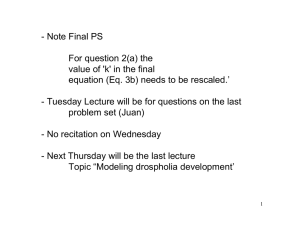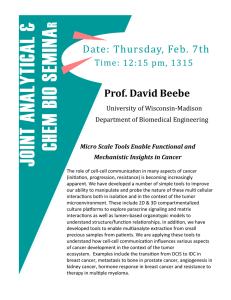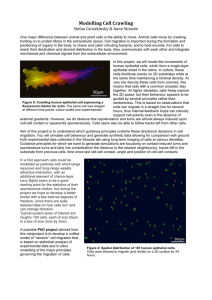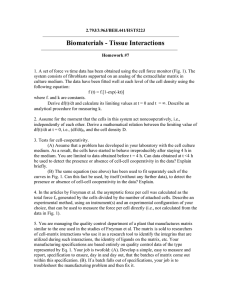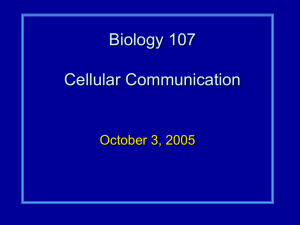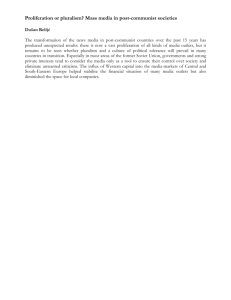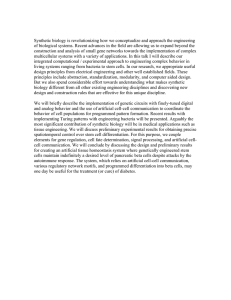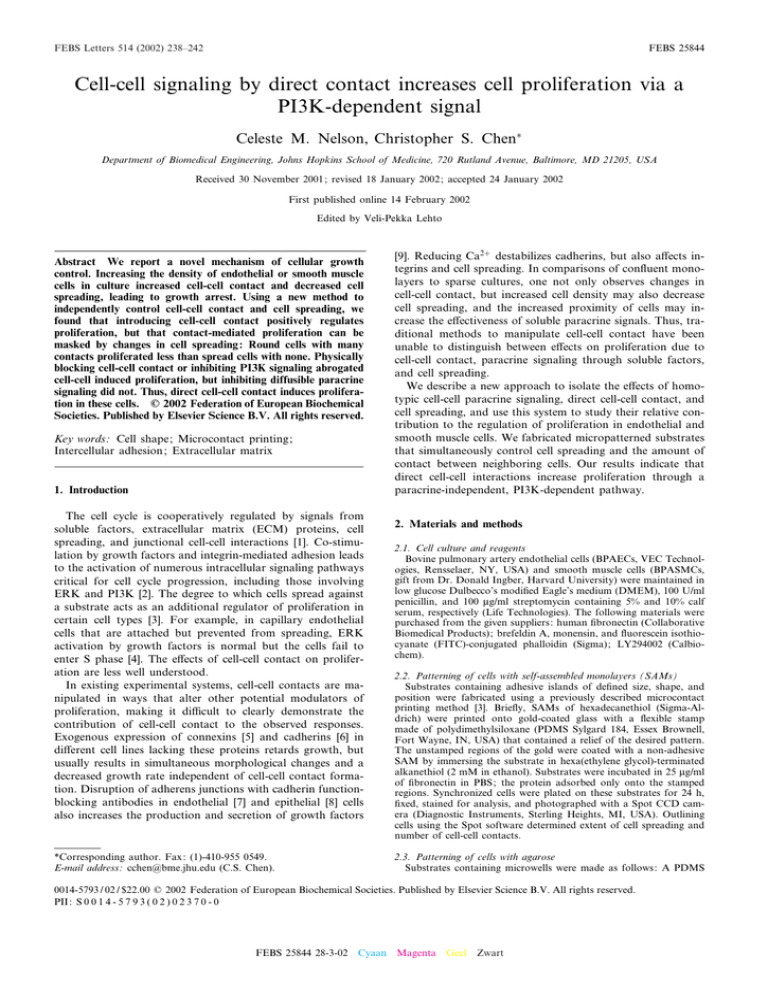
FEBS Letters 514 (2002) 238^242
FEBS 25844
Cell-cell signaling by direct contact increases cell proliferation via a
PI3K-dependent signal
Celeste M. Nelson, Christopher S. Chen
Department of Biomedical Engineering, Johns Hopkins School of Medicine, 720 Rutland Avenue, Baltimore, MD 21205, USA
Received 30 November 2001; revised 18 January 2002; accepted 24 January 2002
First published online 14 February 2002
Edited by Veli-Pekka Lehto
Abstract We report a novel mechanism of cellular growth
control. Increasing the density of endothelial or smooth muscle
cells in culture increased cell-cell contact and decreased cell
spreading, leading to growth arrest. Using a new method to
independently control cell-cell contact and cell spreading, we
found that introducing cell-cell contact positively regulates
proliferation, but that contact-mediated proliferation can be
masked by changes in cell spreading: Round cells with many
contacts proliferated less than spread cells with none. Physically
blocking cell-cell contact or inhibiting PI3K signaling abrogated
cell-cell induced proliferation, but inhibiting diffusible paracrine
signaling did not. Thus, direct cell-cell contact induces proliferation in these cells. ß 2002 Federation of European Biochemical
Societies. Published by Elsevier Science B.V. All rights reserved.
Key words: Cell shape; Microcontact printing;
Intercellular adhesion; Extracellular matrix
1. Introduction
The cell cycle is cooperatively regulated by signals from
soluble factors, extracellular matrix (ECM) proteins, cell
spreading, and junctional cell-cell interactions [1]. Co-stimulation by growth factors and integrin-mediated adhesion leads
to the activation of numerous intracellular signaling pathways
critical for cell cycle progression, including those involving
ERK and PI3K [2]. The degree to which cells spread against
a substrate acts as an additional regulator of proliferation in
certain cell types [3]. For example, in capillary endothelial
cells that are attached but prevented from spreading, ERK
activation by growth factors is normal but the cells fail to
enter S phase [4]. The e¡ects of cell-cell contact on proliferation are less well understood.
In existing experimental systems, cell-cell contacts are manipulated in ways that alter other potential modulators of
proliferation, making it di¤cult to clearly demonstrate the
contribution of cell-cell contact to the observed responses.
Exogenous expression of connexins [5] and cadherins [6] in
di¡erent cell lines lacking these proteins retards growth, but
usually results in simultaneous morphological changes and a
decreased growth rate independent of cell-cell contact formation. Disruption of adherens junctions with cadherin functionblocking antibodies in endothelial [7] and epithelial [8] cells
also increases the production and secretion of growth factors
*Corresponding author. Fax: (1)-410-955 0549.
E-mail address: cchen@bme.jhu.edu (C.S. Chen).
[9]. Reducing Ca2 destabilizes cadherins, but also a¡ects integrins and cell spreading. In comparisons of con£uent monolayers to sparse cultures, one not only observes changes in
cell-cell contact, but increased cell density may also decrease
cell spreading, and the increased proximity of cells may increase the e¡ectiveness of soluble paracrine signals. Thus, traditional methods to manipulate cell-cell contact have been
unable to distinguish between e¡ects on proliferation due to
cell-cell contact, paracrine signaling through soluble factors,
and cell spreading.
We describe a new approach to isolate the e¡ects of homotypic cell-cell paracrine signaling, direct cell-cell contact, and
cell spreading, and use this system to study their relative contribution to the regulation of proliferation in endothelial and
smooth muscle cells. We fabricated micropatterned substrates
that simultaneously control cell spreading and the amount of
contact between neighboring cells. Our results indicate that
direct cell-cell interactions increase proliferation through a
paracrine-independent, PI3K-dependent pathway.
2. Materials and methods
2.1. Cell culture and reagents
Bovine pulmonary artery endothelial cells (BPAECs, VEC Technologies, Rensselaer, NY, USA) and smooth muscle cells (BPASMCs,
gift from Dr. Donald Ingber, Harvard University) were maintained in
low glucose Dulbecco's modi¢ed Eagle's medium (DMEM), 100 U/ml
penicillin, and 100 Wg/ml streptomycin containing 5% and 10% calf
serum, respectively (Life Technologies). The following materials were
purchased from the given suppliers: human ¢bronectin (Collaborative
Biomedical Products); brefeldin A, monensin, and £uorescein isothiocyanate (FITC)-conjugated phalloidin (Sigma); LY294002 (Calbiochem).
2.2. Patterning of cells with self-assembled monolayers (SAMs)
Substrates containing adhesive islands of de¢ned size, shape, and
position were fabricated using a previously described microcontact
printing method [3]. Brie£y, SAMs of hexadecanethiol (Sigma-Aldrich) were printed onto gold-coated glass with a £exible stamp
made of polydimethylsiloxane (PDMS Sylgard 184, Essex Brownell,
Fort Wayne, IN, USA) that contained a relief of the desired pattern.
The unstamped regions of the gold were coated with a non-adhesive
SAM by immersing the substrate in hexa(ethylene glycol)-terminated
alkanethiol (2 mM in ethanol). Substrates were incubated in 25 Wg/ml
of ¢bronectin in PBS; the protein adsorbed only onto the stamped
regions. Synchronized cells were plated on these substrates for 24 h,
¢xed, stained for analysis, and photographed with a Spot CCD camera (Diagnostic Instruments, Sterling Heights, MI, USA). Outlining
cells using the Spot software determined extent of cell spreading and
number of cell-cell contacts.
2.3. Patterning of cells with agarose
Substrates containing microwells were made as follows: A PDMS
0014-5793 / 02 / $22.00 ß 2002 Federation of European Biochemical Societies. Published by Elsevier Science B.V. All rights reserved.
PII: S 0 0 1 4 - 5 7 9 3 ( 0 2 ) 0 2 3 7 0 - 0
FEBS 25844 28-3-02 Cyaan Magenta Geel Zwart
C.M. Nelson, C.S. Chen/FEBS Letters 514 (2002) 238^242
239
stamp containing bowtie-shaped posts was oxidized under UV/ozone
(UVO Cleaner, Jelight Company, Inc., Irvine, CA, USA) and sealed
against a SuperFrost slide (Fisher Scienti¢c); the bowtie-shaped posts
protected corresponding regions of glass, leaving other regions exposed. A solution of 0.6% agarose (Life Technologies)/40% ethanol
in water was wicked under the stamp and dried under vacuum. The
agarose coated the glass in the channels formed between the stamp
and the slide. Peeling o¡ the slide left glass-bottomed bowtie-shaped
wells on the substrate. Substrates were sterilized in ethanol, washed
with PBS, and incubated in a 25 Wg/ml solution of ¢bronectin in PBS.
2.4. BrdU incorporation
Entry into S phase was quanti¢ed by measuring the percentage of
cells that incorporated 5-bromo-2P-deoxyuridine (BrdU) using a commercial assay (Amersham). Cells were G0 -synchronized by holding
cultures at con£uence for 2 days, then plated onto substrates in full
culture media. BrdU was added to the medium at 2 h after plating. At
24 h, cells were ¢xed and stained according to the manufacturer's
instructions. BrdU-positive £uorescent cells were visualized and
scored using a Nikon epi£uorescence microscope (Nikon). The
DNA-binding dye Hoechst 33258 (Molecular Probes) was used as a
counterstain (1 Wg/ml).
2.5. Statistical analysis
Statistical signi¢cance was determined using the Student's t-test.
3. Results
We ¢rst examined the e¡ect of cell density on cell spreading, cell-cell contact, and cell proliferation. G0 -synchronized
endothelial and smooth muscle cells were plated at densities
ranging from 300 to 90 000 cells/cm2 , where the highest density was comparable to that of a con£uent monolayer (Fig.
1A,B). After 24 h, cells were ¢xed and analyzed for quantity
of cell-cell contact, cell spreading, and cell proliferation. Cell-
Fig. 2. Proliferation increases with both increasing cell area and increasing cell-cell interactions. A: Phase contrast micrograph of
BPAECs cultured on square islands (50 Wm on a side). The inset
shows how cells are outlined, cell area calculated, and number of
neighboring cells speci¢ed for each cell. Bar = 50 Wm. B: Graph of
percentage of cells incorporating BrdU as a function of mean cell
area and number of cell-cell contacts in BPAEC (EC). C: Graph of
BrdU incorporation as a function of mean cell area and number of
cell-cell contacts in BPASMC (SMC). The data represent the
mean þ S.D. of three experiments, with (*) indicating P 6 0.05 between indicated bar and both its control and neighboring bar.
Fig. 1. Proliferation decreases with increasing cell density. A,B:
Phase contrast images of BPAECs (EC) and BPASMCs (SMC) at
seeding densities of 9000 cells/cm2 and 900 cells/cm2 . Bar = 50 Wm.
C,D: Plots of mean cell area as a function of seeding density calculated from a representative experiment. E,F: Plots of the percentage
of cells that incorporate BrdU as a function of cell density. Error
bars indicate S.D. across three experiments. Data are shown for
both BPAECs (A,C,E) and BPASMCs (B,D,F).
cell contact and spreading both changed with plating density
(Fig. 1C,D). As cell density was increased, cell-cell contact
increased, with cells ¢rst contacting each other at a seeding
density of 3000 cells/cm2 , and being fully surrounded at 30 000
cells/cm2 . Cell spreading, as measured by projected cellular
area, decreased with increasing cell density, with the most
dramatic decrease in the 3000^30 000 cells/cm2 range. Cell
proliferation, as measured by the percentage of G0 -synchronized cells incorporating BrdU after plating, decreased with
increasing cell density (Fig. 1E,F), suggesting that either
cell-cell interactions or cell spreading may be involved in
growth regulation. However, it was not clear what the relative
contributions of cell spreading and cell-cell interactions are to
cell proliferation.
FEBS 25844 28-3-02 Cyaan Magenta Geel Zwart
240
C.M. Nelson, C.S. Chen/FEBS Letters 514 (2002) 238^242
Fig. 3. A new patterning method reveals that pairs of contacting endothelial cells proliferate more than single cells. A: Schematic outline of agarose patterning. B: Fluorescence image of cells on agarose patterns stained with FITC-phalloidin and Hoechst 33258.
Bar = 20 Wm. C: BrdU incorporation of pairs and single cells grown
on bowties pattern, where `singles' indicates cells that attach and
spread primarily in half of the bowtie-shaped well, leaving the other
half empty. The data represent the mean þ S.D. of four experiments,
with (*) indicating P 6 0.005.
To decouple cell-cell interactions from cell spreading, we
used a micropatterning technique to fabricate arrays of microcultures on a substrate [3]. We microcontact printed self-assembled monolayers (SAMs) of alkanethiolates to generate
arrays of micrometer-scale islands coated with ¢bronectin
and separated by non-adhesive regions. When plated on
SAM substrates, cell attachment and spreading are restricted
to the area of the adhesive islands. By plating cells on islands
ranging from 100 Wm2 to 10 000 Wm2 , and varying the number
of cells on each island (Fig. 2A), we could vary the number of
cell-cell interactions independently of the extent of cell spreading. For example, single cells on 625 Wm2 islands have equal
spreading but fewer contacts than four cells on 2500 Wm2
islands do. Similarly, this approach can be used to vary cell
spreading without varying the number of cell-cell contacts.
We plated G0 -synchronized cells on ¢bronectin-coated islands and measured cell spreading, number of cell-cell contacts, and proliferation on a cell-by-cell basis at 24 h after
plating for thousands of cells. Proliferation increased signi¢cantly (P 6 0.005) with increasing cell spreading in isolated
cells (Fig. 2B,C, white bars), in agreement with previous reports [3,4]. At each degree of cell spreading, increasing cell-cell
interactions resulted in an additional, statistically signi¢cant
increase in proliferation (P 6 0.05; Fig. 2B,C). This e¡ect was
most dramatic in the least spread cells: Cell-cell contact increased proliferation by as much as three-fold in round cells
but by only 20% in highly spread cells.
For a given island size and number of cells per island, we
found that the degree of cell spreading and cell-cell contact
varied from cell to cell and likely contributed to the large
variation in proliferation seen in Fig. 2. To circumvent this
variability, we patterned substrates with a 10-Wm-thick layer
of non-adhesive agarose surrounding bowtie-shaped patterns
on glass coated with ¢bronectin (Fig. 3A). When plated on
these substrates, pairs of cells spread to ¢ll the bowtie-shaped
microwells (750 Wm2 per half), with one cell on each side of
the central constriction, while single cells attached in a bowtie
were primarily con¢ned to half of the microwell (Fig. 3B).
Intercellular adhesion molecules expressed in these cells, including connexin 43, N-cadherin, VE-cadherin, and beta-catenin, were found to localize to cell-cell contacts within 4 h
after plating onto the patterned substrates (data not shown).
The proliferation rate of single cells in the microwells was
comparable to that seen in cells without contacts on the
Fig. 4. A di¡usible factor is not responsible for the increased proliferation seen with increasing cell-cell interactions. Graphs of BrdU incorporation in BPAEC treated with di¡erent concentrations of (A) brefeldin A and (B) monensin. C: Phase contrast image of pairs of BPAECs separated by 2 Wm (right) and 5 Wm (left) gaps. D: Graph of BrdU incorporation in cells grown with gaps. White bars represent single cells; gray
bars represent cells grown in pairs. E: Graph of BrdU incorporation in BPAEC treated with di¡erent concentrations of LY294002. The data
represent the mean þ S.D. of at least three independent experiments, with *P 6 0.005.
FEBS 25844 28-3-02 Cyaan Magenta Geel Zwart
C.M. Nelson, C.S. Chen/FEBS Letters 514 (2002) 238^242
SAM patterns. The proliferation rate nearly doubled for cells
grown in pairs (Fig. 3C).
To determine if a soluble factor was responsible for the cellcell-mediated increase in proliferation, we compared the proliferation rates of pairs of cells with those of single cells on
patterns that were treated with brefeldin A (Fig. 4A) and
monensin (Fig. 4B) to disrupt protein secretion. Both drugs
caused an overall decrease in proliferation with increasing
dose, but neither drug preferentially blocked the enhanced
proliferation seen in cells grown as pairs. Treatment with
the growth factor receptor inhibitor suramin also did not
abrogate the increase in proliferation in cells grown in pairs
(data not shown).
Conversely, to test whether di¡usible paracrine signals
mediated cell-cell induced proliferation in the absence of physical contact, we plated cells on substrates where the bowtieshaped pattern was bisected with a strip of non-adhesive agarose, leaving 2 and 5 Wm-sized gaps between neighboring cells
(Fig. 4C). The gaps were su¤ciently narrow to allow proteins
secreted by one cell in a pair to di¡use across to the other cell,
based on a simple di¡usion model (data not shown). The
proliferation rates of cells grown in these separated pairs
dropped to the levels of single cells (Fig. 4D), con¢rming
that direct contact between cells and not di¡usible signaling
is responsible for the increase in proliferation due to cell-cell
interactions.
To begin to characterize the intracellular basis for direct
cell-cell contact-mediated proliferation, we explored whether
any traditional signal transduction pathways associated with
growth factor-mediated proliferation were involved. To determine if PI3K was involved in the increase in proliferation, we
treated cells grown on bowtie-shaped islands with increasing
concentrations of LY294002 (Fig. 4E). Blocking PI3K completely inhibited the increase in proliferation of pairs over
single cell controls at speci¢c concentrations of the inhibitor.
Further increasing LY294002 concentration inhibited cell
spreading (data not shown). These results indicate that signaling through PI3K is necessary for the increase in proliferation
with cell-cell contact, and that cell-cell signaling is even more
sensitive to PI3K inhibition than traditional growth factor
signaling.
4. Discussion
Cell-cell contact positively regulates proliferation. Our results demonstrate that cells contacting one or more neighbors
have a signi¢cant growth advantage over single cells without
contacts, contradicting the previously held notion that cell-cell
contact inhibits cell proliferation [10,11]. Our data suggest
that past studies may have been confounded by an inability
to separate e¡ects of cell-cell contact and cell spreading. Decreasing cell spreading appears to inhibit proliferative signals
and may mask positive signals from cell-cell contact: Round
cells with maximal contact (representing `con£uent' cells) still
proliferate much less than spread cells with no contacts (representing `sparse' cells). In the geometry of feeder layer-dependent cultures, which allows for contact-mediated signaling
without constraining cell spreading, contact has been shown
to improve proliferation of various cell types [12,13]. Thus,
`contact inhibition' of growth of cells cultured in monolayers
may be less a result of cell-cell contact and more a result of
the decreased spreading as cells become crowded. The ob-
241
served increase in proliferation with cell-cell contact, only apparent when spreading was controlled, suggests that future
studies of contact-mediated proliferation should use methods
to control confounding factors such as cell spreading. The
technique to achieve this control described in the present
study is relatively simple, relies on reagents available in typical
biological laboratories, and appears to preserve the normal
structure of cell-cell contacts.
The positive e¡ect of cell-cell contact is due to molecules
engaged when the cells physically touch and not to a di¡usible
factor. A number of molecular players may be involved, including gap junctions, cadherins, and CAMs. Each of these
has been shown to regulate proliferation in other systems, and
although the majority of studies conclude that cell-cell contact
via these molecules inhibits proliferation, ours is not the ¢rst
study to ¢nd that cell-cell contact stimulates growth. For example, although overexpressing connexins in some cancer cell
lines leads to decreased growth [5], enhancement of gap junctional communication by connexin 43 expression increases
proliferation in others [14]. Similarly, although cadherins are
thought to negatively a¡ect proliferation by sequestering betacatenin [15], recent ¢ndings have shown that cadherins can
bind to and activate growth factor receptors [16], and thereby
positively regulate cell cycle progression. N-CAM, a member
of the Ig-like cell adhesion molecule family, can induce FGF
receptor signaling [17]. Aside from cell-cell adhesion molecules, immobilized growth factors in membrane- or ECMbound forms, such as bFGF [18] or HB-EGF [19], could
also be responsible for the observed phenomenon, since the
membrane-bound form is likely to be substantially more potent as a signal due to its partial immobilization [20].
We show that PI3K is necessary for the increase in proliferation due to cell-cell contact (Fig. 4). PI3K mediates proliferation through several players, including protein kinase C,
phosphoinositide-dependent kinases and MAPK, and is activated in classical mitogenic pathways such as those through
growth factor receptors and integrins [21,22]. Surprisingly, the
cell-cell pathway is far more dependent on PI3K signaling
than the more traditional pathways, implying that cell-cell
contact has fewer redundant, parallel pathways leading to
proliferation. The mechanism by which cell-cell contact leads
to PI3K stimulation is not known, but given the number of
known upstream stimulators (growth factor receptors, nonreceptor (p60-src) tyrosine kinases, Ras, and members of the
Rho family of GTPases [22]), it is reasonable to conjecture
that several pathways are involved. Cadherin engagement has
recently been shown to upregulate both Rac and Cdc42 activity in epithelial cells [23]. Because it is unlikely that cell-cellmediated mitogenic e¡ects would be limited to signaling
through one pathway, other independent mechanisms must
be considered, including the Wnt signal transduction pathway.
Engagement of the Wnt receptor inactivates GSK-3L, stabilizing cytoplasmic beta-catenin, an essential coactivator of Lef/
Tcf transcription factors [15]. Since cadherins bind and sequester beta-catenin [24], and GSK-3L has recently been
shown to be inhibited by PI3K signaling [25], it will be important to determine what roles beta-catenin and GSK-3L
might play in cell-cell contact-stimulated proliferation.
The ¢nding that cell-cell contact stimulates proliferation is
consistent with many physiological processes. During angiogenesis, endothelial cells must proliferate in a directed manner
and still maintain cell-cell contacts to ensure the integrity of
FEBS 25844 28-3-02 Cyaan Magenta Geel Zwart
242
C.M. Nelson, C.S. Chen/FEBS Letters 514 (2002) 238^242
the vasculature. During wound healing, it is conceivable that
enhanced proliferation of cells at the leading edge over isolated cells scattered in the wound would lead to a faster, more
directed mode of wound closure. Indeed, bFGF has been
found to increase connexin 43 expression and intercellular
communication in endothelial cells and ¢broblasts, suggesting
that increased cell coupling might be necessary for the coordination of these cells in wound healing and angiogenesis [26].
Thus, cell-cell contact might not only increase survival by
protecting cells from dying, but also by stimulating them to
divide.
Finally, given that we and others have seen opposing e¡ects
of cell-cell contact on proliferation, cell-cell contact may have
numerous molecular players that each act as positive and
negative regulators. Thus, as in growth factor and integrin
signaling, several receptors may be simultaneously engaged
to signal the cell, and the speci¢c conditions surrounding individual cells may alter the panoply of receptors that ultimately dominate to control a particular cell's fate.
Acknowledgements: This work was supported in part by the Whitaker
Foundation, NIGMS (GM 60692), and DARPA. We thank John L.
Tan, Joe Tien, Joe G.N. Garcia, and Lew Romer for helpful discussions. C.M.N. acknowledges ¢nancial support from the Whitaker
Foundation.
References
[1] Eliceiri, B.P. and Cheresh, D.A. (2001) Curr. Opin. Cell Biol. 13,
563^568.
[2] Assoian, R.K. and Schwartz, M.A. (2001) Curr. Opin. Genet.
Dev. 11, 48^53.
[3] Chen, C.S., Mrksich, M., Huang, S., Whitesides, G.M. and
Ingber, D.E. (1997) Science 276, 1425^1428.
[4] Huang, S., Chen, C.S. and Ingber, D.E. (1998) Mol. Biol. Cell 9,
3179^3193.
[5] Hellmann, P., Grummer, R., Schirrmacher, K., Rook, M.,
Traub, O. and Winterhager, E. (1999) Exp. Cell Res. 246, 480^
490.
[6] Levenberg, S., Yarden, A., Kam, Z. and Geiger, B. (1999) Oncogene 18, 869^876.
[7] Caveda, L., Martin-Padura, I., Navarro, P., Breviario, F., Corada, M., Gulino, D., Lampugnani, M.G. and Dejana, E. (1996)
J. Clin. Invest. 98, 886^893.
[8] Kandikonda, S., Oda, D., Niederman, R. and Sorkin, B.C.
(1996) Cell Adhes. Commun. 4, 13^24.
[9] Castilla, M.A., Arroyo, M.V., Aceituno, E., Aragoncillo, P.,
Gonzalez-Pacheco, F.R., Texeiro, E., Bragado, R. and Caramelo,
C. (1999) Circ. Res. 85, 1132^1138.
[10] St. Croix, B., Sheehan, C., Rak, J.W., Florenes, V.A., Slingerland, J.M. and Kerbel, R.S. (1998) J. Cell Biol. 142, 557^571.
[11] Sasaki, C.Y., Lin, H., Morin, P.J. and Longo, D.L. (2000) Cancer Res. 60, 7057^7065.
[12] Ohno, T. and Yamada, M. (1984) Biomed. Pharmacother. 38,
337^443.
[13] Ehmann, U.K., Stevenson, M.A., Calderwood, S.K. and DeVries, J.T. (1998) Exp. Cell Res. 243, 76^86.
[14] Gramsch, B., Gabriel, H.D., Wiemann, M., Grummer, R., Winterhager, E., Bingmann, D. and Schirrmacher, K. (2001) Exp.
Cell Res. 264, 397^407.
[15] Stockinger, A., Eger, A., Wolf, J., Berg, H. and Foisner, R.
(2001) J. Cell Biol. 154, 1185^1196.
[16] Williams, E.J., Williams, G., Howell, F.V., Skaper, S.D., Walsh,
F.S. and Doherty, P. (2001) J. Biol. Chem. 276, 43879^43886.
[17] Cavallaro, U. and Niedermeyer, J. (2001) Nat. Cell Biol. 3, 650^
657.
[18] Vlodavsky, I., Fuks, Z., Ishai-Michaeli, R., Bashkin, P., Levi, E.,
Korner, G., Bar-Shavit, R. and Klagsbrun, M. (1991) J. Cell.
Biochem. 45, 167^176.
[19] Nakamura, K., Iwamoto, R. and Mekada, K. (1995) J. Cell Biol.
129, 1691^1705.
[20] Zandstra, P.W., Lau¡enburger, D.A. and Eaves, C.J. (2000)
Blood 96, 1215^1222.
[21] King, W.G., Mattaliano, M.D., Chan, T.O., Tsichlis, P.N. and
Brugge, J.S. (1997) Mol. Cell. Biol. 17, 4406^4418.
[22] Katso, R., Okkenhaug, K., Ahmadi, K., White, S., Timms, J.
and Water¢eld, M.D. (2001) Annu. Rev. Cell Dev. Biol. 17,
615^675.
[23] Noren, N.K., Niessen, C.M., Gumbiner, B.M. and Burridge, K.
(2001) J. Biol. Chem. 276, 33305^33308.
[24] Goichberg, P., Shtutman, M., Ben-Ze'ev, A. and Geiger, B.
(2001) J. Cell Sci. 114, 1309^1319.
[25] Cross, D.A., Alessi, D.R., Cohen, P., Andjelkovich, M. and
Hemmings, B.A. (1995) Nature 378, 785^789.
[26] Abdullah, K.M., Luthra, G., Bilski, J.J., Abdullah, S.A., Reynolds, L.P., Redmer, D.A. and Grazul-Bilska, A.T. (1999) Endocrine 10, 35^41.
FEBS 25844 28-3-02 Cyaan Magenta Geel Zwart

